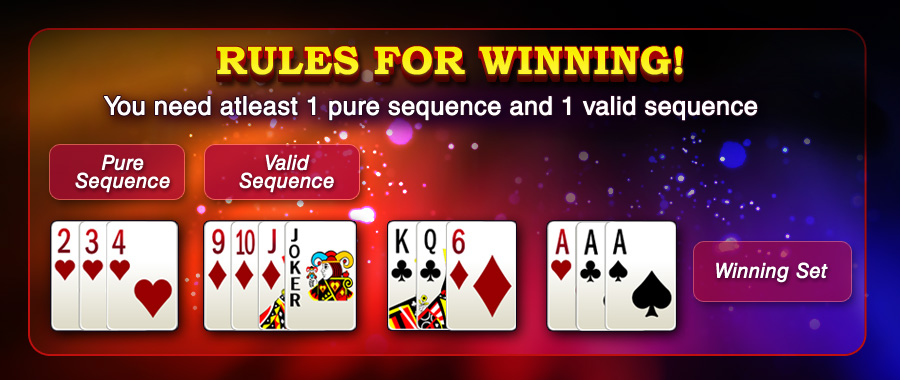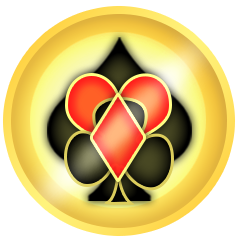How To Play Rummy Card Game: Get Started With Rummy Rules
Rummy is a card game that is played with two decks of cards with total of two Jokers. To win the rummy game a player must make a valid declaration by picking and discarding cards from the two piles given. One pile is a closed deck, where a player is unable to see the card that he is picking, while the other is an open deck that is formed by the cards discarded by the players. To win at rummy card game, the players have to group cards in valid sequences and sets.
In rummy, the cards in each suit rank low to high starting with Ace, 2, 3, 4, 5, 6, 7, 8, 9, 10, Jack, Queen and King. Ace, Jack, Queen and King each has 10 points. The remaining cards have value equal to their face value. For example, 5 cards will have 5 points and so on.
The Objective Of Rummy
The objective of rummy card game is to arrange the 13 cards in valid sets and sequences. To win the game you need to make minimum 2 sequences, out of which one needs to be pure sequence and rest can be any valid sequence or sets. Without a pure sequence you cannot make a valid rummy declaration. This is one of the most important rummy rules.

How to Form Sequences?
In rummy, a sequence is a group of three or more consecutive cards of the same suit. There are two types of sequences that are formed; a pure sequence and an impure sequence. To win the game of rummy you need at least one pure sequence in your rummy hand.
Pure Sequence
A pure sequence is a group of three or more cards of the same suit, placed in consecutive order. To form a pure sequence in rummy card game, a player cannot use any Joker or wild card.
Here are a few examples of pure sequence.
- 5♥ 6♥ 7♥ (Pure sequence with three cards and there is no Joker or wild card used)
- 3♠ 4♠ 5♠ 6♠ (Pure sequence with four cards. There is no use of Joker or wild cards here.)
Impure Sequence
An impure sequence is a group of three or more cards of the same suit with one or more Joker card used.
Here are some examples to show how an impure sequence is formed.
- 6♦ 7♦ Q♠ 9♦ (Here Q♠ has been used as a wild Joker replacing 8♦ to form an impure sequence.)
- 5♠ Q♥ 7♠ 8♠ PJ (Impure sequence with Q♥ as wild joker that is replacing 6♠ and the Printed Joker is replacing 9♠.)
How to Form Sets?
A set is a group of three or more cards of the same value but of different suits. When you are forming sets, you can use wild card and Jokers.
Examples of sets
- A♥ A♣ A♦ (In this set, all the Ace are of different suits, make a valid set.)
- 8♦ 8♣ 8♠ 8♥ (Rummy set is formed with four 8 cards of different suits.)
- 9♦ Q♠ 9♠ 9♥ (Here Q♠ has been used as wild joker replacing 9♣ to make set.)
- 5♦ 5♣ 5♠ PJ (Printed joker replacing 5♥ to make set.)
- 5♦ 5♣ Q♠ PJ (Here Q♠ has been used as wild joker replacing 5♠ & Printed joker replacing 5♥ to make set.)
- 5♦ 5♣ PJ Q♥ Q♠ (This is a set of 5 cards with Printed joker & Q♥ as wild joker replacing 5♠ 5♥ and one more wild joker Q♠ to complete 13 cards grouping.)
Typical Example: 2♥ 3♥ 4♥ 5♥| 5♣ 6♣ 7♣ 8♣ | 5♦ 5♣ PJ Q♥ Q♠ (Set of 5 cards is made to complete the grouping of 13 cards and make a valid declaration)
Note: The set is formed with same card of different suits. However, you can’t use two or more cards of the same suit. This is taken as an invalid declaration. Also, note that a set can have more than four cards. So, if you have a set of four cards and you are using an additional Joker, then in total it becomes a 5 cards group and still be a valid set. At no given time, the hand can have more than 13 cards.
Examples of invalid set
- Q♥ Q♥ Q♦ (There are two Qs of the same suit ♥ making it an invalid set.)
- 7♠ 7♥ 7♦ 7♠ Q♥ (It has two 7 spades of the same suit. The wild card Q♥ as the fifth card is valid but having two 7♠ is making it invalid.)
